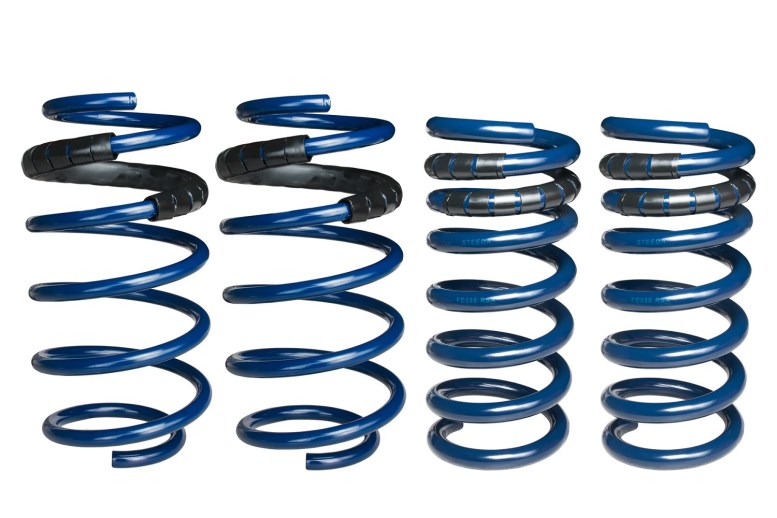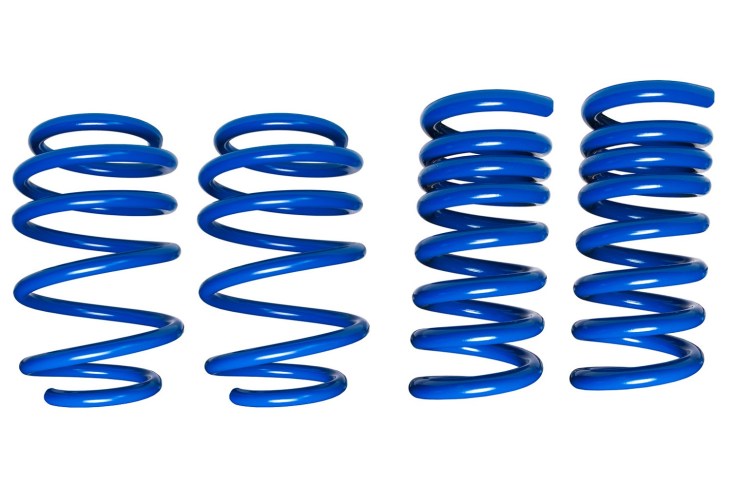Before you upgrade from your factory springs, it is important to understand how different springs operate, and what the pros and cons are of each type. You also need to keep in mind what your plans are for your car - is it going to be track only? drag racing? just some fun on the back roads? These are crucial considerations to take into account, as the car's use will determine its weight variability, which ultimately influences the optimal solution for your car's springs.
First, let it be stated that there is no perfect solution - it's essentially impossible to create a product that is all pros and no cons. With that said, there are "best solutions" and this article is here to help you find that best solution. So what are the basic differences between linear rate, progressive rate, and dual rate springs?
[caption id="attachment_4982" align="alignnone" width="761"] Steeda S550 EcoBoost Linear Sport
Springs[/caption]
Steeda S550 EcoBoost Linear Sport
Springs[/caption]
Linear rate springs feature a standard spring rate per inch of deflection throughout their entire range of deflection. To simplify all that technical jargon, let's imagine you have a 400lb/inch linear rate spring that is 10" long. If the spring bares 400 pounds, it will be compressed 1", giving it a spring height of 9". If you add another 400lb, the spring will then have an 8" spring height, and so on. The linearity of the spring simplifies the process of setting up a specific vehicle's ride height because as we just saw, it's a simple "plug-and-chug" math problem. Due to their simplicity, linears are the most common, and easiest spring to manufacture, meaning they are generally the least expensive. There is an extremely wide range of options, so it is fairly easy to find linear rate springs for any given vehicle. On the other hand, linear springs provide no support for roll-control, meaning it's all left up to the sway bar (why? It's simple: in a turn, the springs on the inside will be pushing up at the same rate as the springs are being compressed on the outside). If you're going to both track your car and use it on the street, linears may provide you with an unsatisfactory compromise, since an ideal track-spring setup would be different from an ideal street-spring setup.
[caption id="attachment_4980" align="alignnone" width="777"] Steeda S550 Progressive Sport
Springs[/caption]
Steeda S550 Progressive Sport
Springs[/caption]
Progressive rate springs, as the name suggests, have a constantly increasing spring rate throughout their range of deflection. This means that the distance between coils progressively increases from one end to the other, allowing for more weight variability. Progressive Springs optimize the center of gravity and suspension geometry creating a huge improvement in handling with a noticeable reduction in nosedive, launch squat, and body roll, while still maintaining an outstanding ride quality for daily driving. It may help to think of them as "load-compensating," in that the more weight you add to the vehicle (passengers, cargo, etc) the springs will progressively compress less so that they don't end up fully compressed. Generally speaking, these are the best of both worlds, providing an exceptional improvement in handling and assistance in roll-control, without compromising ride comfort. With these improvements over linear springs, it's understood why they cost more. They also require you to pay more attention to your full suspension setup, which means greater consideration of the shocks and struts you'll pair them with.
[caption id="attachment_4981" align="alignnone" width="731"] Steeda S550 Mustang Dual Rate
Ultimate Handling Springs[/caption]
Steeda S550 Mustang Dual Rate
Ultimate Handling Springs[/caption]
Lastly, we have dual rate springs. These are easy to spot because, as the image shows, they have tightly spaced coils at one end and wider, equally spaced coils at the other end. Usually, the spring rates for dual rate springs are listed as 250/425lb/in, meaning the top part is 250lb/in. and the bottom is 425lb/in. The middle part of the spring is the rate-transition-change area, which is designed to be where the car sits normally. This transition point is fine-tuned with Steeda Dual Rate Ultimate Handling Springs for the ultimate performance in your vehicle. The biggest advantage with dual rate springs is the unmatched handling performance as a result of increased roll control and reduced nosedive. When you are cornering, the side of the car on the outside of the curve rolls over the edge, while the inside edge rolls or lifts up. As the car rolls over, it moves into the higher spring rate, which greatly reduces the amount of roll. On the other side, the car lifts less because it's pushed up by the lighter spring rate. In combination with a sway bar, the car's roll will be almost imperceptible. These springs tend to be used in luxury, performance grand tourers and other high-performance vehicles. With that being said, dual rate springs require a more involved engineering and manufacturing process that requires more time and more resources, leading to higher prices than either linear or progressive springs.

